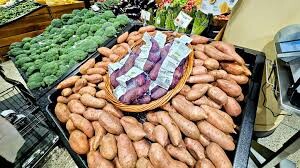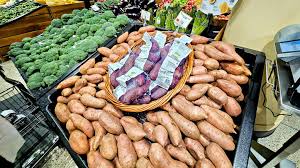
Central America
How is it produced?
Sweet potatoes (Ipomoea batatas) are a root vegetable with roots that go back 5000 years in Central and South America, especially in current Peru and the Mesoamerican regions. Indigenous communities domesticated and cultivated sweet potatoes long before being brought into contact with Europeans. The crop populated the world over the centuries through commerce, colonial expansion, and agricultural adaptation. Today, the leading producers of it are China, the United States (especially North Carolina), and sub-Saharan Africa, which appreciates it highly because of its high yield and nutritional density (Vineland Research and Innovation Centre, 2020; Canadian Food Focus, 2023a).
Sweet potatoes are a new crop in Canada. A small area of about 2000 acres is cultivated due to the climate of the north and is mainly grown in Ontario. Canadian producers depend much on the imported slips (vine cuttings that can be used to multiply the vines), mostly imported from the southeastern U.S., or the state of North Carolina in particular, as local conditions do not permit the early manufacturing of slips (Greenhouse Canada, 2022). When planted, sweet potatoes grow in well-drained sandy soils and are harvested in the fall, after which they are stored in controlled facilities to last long. Development of domestically produced varieties such as Radiance that can weather the Canadian conditions has been coming up (Vineland Research and Innovation Centre, 2020).
Describe the supply chain to the store shelf in Canada:
The sweet potato supply chain starts in the South of the U.S., where slips are cultivated and shipped to the Canadian farmers every spring. These slips are planted in the Canadian fields, usually between May and June. Sweet potatoes are grown during the summer, harvested during September after curing, and stored under controlled temperatures. Then, they are transported to stores all over Canada (Vineland Research and Innovation Centre, 2020; Canadian Food Focus, 2023a).
However, Canadian production can only meet approximately 25 percent of national demand. Because of this, most sweet potatoes in Canadian grocery stores are imported as mature roots, mainly grown in North Carolina, and sometimes in the Caribbean. These imported roots are channeled through major bulk producers like Nordany Produce in Quebec, which sells to the country’s grocery chains such as Loblaws, Sobeys, and Metro (Nordany Produce, n.d.; Greenhouse Canada, 2022).
What is the power balance between the producer and seller?
The supply chain of the sweet potato industry, as in most commodities traded on the planet, experiences a significant power imbalance between the producers and sellers. Canadian farmers depend on imported planting material and have a climate-limiting growing season. The majority are small and do not have the bargaining power, thus having to pay the prices and the quality standards dictated by big retailers or wholesale chains (Vineland Research & Innovation Centre, 2020; Greenhouse Canada, 2022).
Worse still, there is an imbalance at the international level. The farmers of sweet potatoes located in such countries as Honduras or the Dominican Republic can work in extremely adverse conditions, with a very low salary and lacking environmental or labor safeguards. In the meantime, the Global North corporations dominating the packaging, marketing, and distribution process appropriate the lion’s share of the profit. Like cocoa and coffee businesses, retailers call the shots, and farmers have no input on the prices or how they will be sold (ResearchGate, 2021).
Third-party certifications are not in place in the sweet potato market, unlike certification programs in other food systems, despite third parties such as Fairtrade intervening in different food systems. It leads to a situation where ethical sourcing is not monitored, and consumers cannot easily verify such claims as sustainability or even use local procurement.
Can you recommend changes to the system to improve the balance?
Build Canadian Slip Propagation Industry
Production of greenhouse slips could be increased domestically to substantially alleviate reliance on imports (Greenhouse Canada, 2022).
Assistance Cooperative Models
The formation of grower cooperatives would strengthen collective bargaining, allowing producers to negotiate better contract agreements and prices with large buyers.
Local branding in the market/Geographic indication
Implementing traceability programs and branding the sweet potatoes as Canadian-grown sweet potatoes would enhance consumers’ awareness and help the producers achieve higher returns. Such a model can be applied successfully in Brazil, where the flour cooperatives are successful (ResearchGate, 2021; Vineland Research and Innovation Centre, 2020).
Retailer Alliances
Local sourcing initiatives like those implemented by the retailers (e.g., “Buy Ontario-grown sweet potatoes”) would incentivize longer-term contracts, reasonable prices, and potentially, more in-line harvest expectations.
To endear fairness and transparency within the sweet potato supply chain, several reforms are essential:
- Establish a Domestic Slip Industry: To perfect Canadian grower autonomy, the nation should invest in greenhouse propagation of slips, especially on adapted species such as Radiance (Greenhouse Canada, 2022).
- Back up producer Cooperatives: Helping the Canadian growers join cooperatives would empower their bargaining power and enable them to negotiate greater prices and more extended contracts with buyers.
- Implement Ethical Certification Modes: Although the system of Fairtrade has not yet been applied to sweet potato, creating the mode of certification and improving labor and environment-protecting conditions in the countries that sell their goods to Canada is possible. To make compliance possible, NGOs and third-party monitors are to be involved.
- Strengthen Transparency of Trade: Governments must require exposure on the distribution channels of large grocers and importers. Such reports should include information on labor conditions, environmental impact, and the sourcing regions to ensure that consumers are provided with helpful information.
- Hold Trade Agreements Accountable: Canada has taken part in international trade arrangements like CUSMA (the previous NAFTA) and has been a member of the World Trade Organization (WTO), which might be referred to to push further on environmental and labor provisions in the importation of agri-food (Haggart, 2018; Grant & Keohane, 2005).
With these solutions, the supply chain of sweet potatoes will be more sustainable, equitable, and resilient as the global supply chain will treat the local and international producers with justice and dignity.
References/Resources:
Canadian Food Focus. (2023a). Sweet potatoes in Canada. https://canadianfoodfocus.org/on-the-farm/sweet-potatoes-in-canada/
FreshPlaza. (2021). Ontario sweet potato season kicks off. https://www.freshplaza.com/article/9360246/ontario-sweet-potato-season-kicks-off/
Greenhouse Canada. (2022). Sweet potato slip production in Canadian greenhouses. https://www.greenhousecanada.com/sweet-potato-slip-production-in-canadian-greenhouses/
Nordany Produce. (n.d.). Potatoes and sweet potatoes. https://www.nordany.com/en/products/potatoes-and-sweet-potatoes
Reddit. (2023). Why are most sweet potatoes in Canada from the U.S.? https://www.reddit.com/r/ontariofarming/comments/sweet_potatoes_imports/
ResearchGate. (2021). The sweet potato supply chain for the manufacturing process of flour. https://www.researchgate.net/publication/356960305
University of California Davis. (2023). Postharvest technology of horticultural crops (Sweet Potatoes). https://vric.ucdavis.edu/postharvest/sweetpotatoes.htm
Vineland Research and Innovation Centre. (2020). The sweet smell of sweet potato success. https://www.vinelandresearch.com/wp-content/uploads/2020/02/The-sweet-smell-of-sweet-potato-success.pdf

